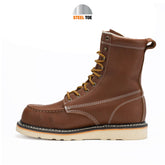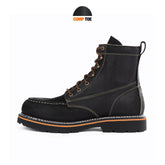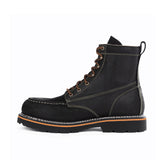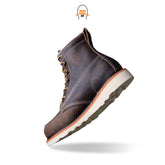Walking the talk: Steel toe work boots keeps you safe on the job!
Whenever I ask someone why they prefer steel toe boots, they always have specific reasons, but the reason that sticks out the most is when they say, “because I dropped something heavy on my foot once, and I’ll never suffer like that again”. Dropping something over one hundred pounds on your toes can mean one of two things, you broke your foot and couldn’t work for a month, or worse, you broke your toes and had to work right through the injury. Both are awful.
The other main reason I see people wearing steel toes is because it’s required for their employment. You show up to work in soft toe boots and you’re sent home without pay. Simple.
I want to talk about the pluses and minuses - I love playing devil’s advocate - and steel toe boots are perfect for that. The pluses, safety.
It’s not just impact from something heavy falling on your foot, it’s punctures. Ever drop a chop saw blade on your foot? Try making that mistake in a soft toe boot. If I’m doing demolition on a wall to extend a kitchen project, I’ll kill power to the wall and use a sledgehammer, but I’m kicking the lower parts with my steel toes. Now I could do some of that with a soft toe boot, but I don’t know what really could be behind that wall. Imagine kicking an exposed nail - or let’s pretend some carpenter 20 years ago left a rusted pry bar inside that wall, and you kick it. You’re going to the hospital without steel toes. You ever broken a toe and split a nail? I have. Let me describe. First you go to the hospital, then the surgeon tells you he’s going to put a rubber ring around your toe (to lock the Novocain in). The needle they use goes right into the knuckle. It’s the most painful event you’ll experience in your life, even more painful than what comes next, when he removes whatever part of the nail is remaining with a pair of needle nose pliers and a scalpel. Once you get past those two parts it’s easy! But for the next six months you never really can feel that toe. It’s there, it’s still part of you, but it’s no longer yours (or at least it never really feels like it is again). I’ve also dropped tires, heads, and an entire engine, on my feet. Steel toes is the only reason why I was able to continue to work. The steel protects not only your toe, but also supports some of the weight of whatever you dropped on it, and when THAT part lands on your foot, it’s less. It’s hard to explain, picture a 500-pound engine slipping off a cherry picker, and the crank pulley lands on your foot. Half the weight of that engine is now being supported by steel, instead of your entire foot. Or picture a car rolling right over your toes, that would be something that would break your foot, the steel will handle that easily. I unfortunately know. Trust me.
But the real advantage outside of safety is performance. In industrial trades you must perform, and while maintaining your health for the entirety of your career. That’s where the money is – no one wants to be bumped up to the front office for a desk job - the desk usually means pay cut. Work as long as you can. To do that you must save your back. Back injuries are career enders. I’ll kick everything. My boots are my tools, I’ll abuse those boots to save my back and knees, always. Anything that needs to be moved or dislodged below my thigh level? I’m using my boots. I’m not risking injury. The steel packs a punch. It carries weight, force, and bad intentions. I’ve kicked struts off steering knuckles. I’ve kicked pavers, walls, tires, two by fours. The boots are tools. My back isn’t.
There are some cons though, here are a few. Weight. The weight of steel toes is noticeable. When you’re doing 10,000-15,000 steps a day, it adds up. Especially when you get older, every step counts, and some will risk safety to be able to work a longer day and go home not feeling totally burnt out. It’s a grind, weeks can be long, no one wants to be exhausted. It’s something to consider.
Comfort (or lack of). Steel toe boots can do two things to the toe box area, one, they can cause a forced bend when stepping. What this means is, instead of your foot controlling the bend and flex of the boot, the steel toe area takes over and makes that decision for you. That can be good, and that can be bad. It depends on your foot, and where the steel toe dictates where that bend will be. A larger toe box area helps. Which brings me to my next negative. Steel toes takes up space, some brands will make you feel like your toes are squished together. Not a good feeling during those twelve-hour days. The other thing is the cold. Cold weather sometimes can transfer right through the steel. If you’re working on a job site outside in the winter, this means something for you. You’re battling those elements. You’re dressing in layers and managing the cold and your body temperature. Nothing worse than cold feet because it impacts your temperature. Another thing - if you do use your feet a lot for work - and you are kicking a lot, some people can actually feel the difference between composite toes and steel. And when you’re using your feet THAT much, remember where your toes go. They go right into that steel when you kick. That’s just a fact. Foot moves forward in the boots, and toes impact the steel. It can add up. Another thing…you ever notice what the leather looks like on a steel toed boot after a few months of hard work? It can get worn out pretty fast, and when you’re spending two hundred dollars on a pair of boots, you don’t want them looking like they’re two years old after three months.
But here’s my own honest opinion, if you’re young, go with steel toe boots. When you’re young, your legs are young and pliable - you won’t notice the extra weight. You have thirty years of working left in you, don’t risk catastrophic injury. If you’re not young, every step counts, every ounce of comfort counts. You’ve already worked for a long time, and you’ve hopefully learned how to be responsible and safe in the workplace. Go with a soft toe boot if you can.
The decision is a struggle for some, easy for others. Whatever you choose, just remember they're your feet, it’s your career. Choose wisely.







